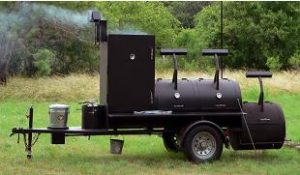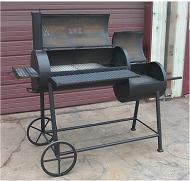


Description
“Stick Burners” are designed to cook with natural wood logs, although charcoal can be used as well. There are infinite variations, with price tags from under $100 to over $100,000, but the most common is the “horizontal offset,” which is identified by the horizontal cooking chamber, a firebox hanging down (offset) at one end, and a smoke stack at the other. Generally, there is an air inlet damper on the firebox and an outlet damper on the stack.
Operation
The Stick Burner is the most challenging type of pit to control and is often a novice’s first pit. This is a bad combination. As we learned in How Wood Burns, restricting combustion air is an easy way to control pit temperature, but doing so will degrade smoke quality. Unfortunately, the Stick Burner’s only controls – the inlet and outlet dampers – do just that, and it’s left to the pit boss to learn the fire management techniques that keep temperature and smoke quality simultaneously in control. The common thinking error is to take a “log-forward” approach instead of a “meat-back” one.
The log-forward approach starts with logs, commonly available in 16″ to 24″ lengths, and usually split as little as the supplier can get away with. Big logs must mean less frequent tending, which seems good. This leads us to buy a pit with a big firebox, 20″ or 24″ square. Now we need a fire. Since we can’t make a fire with one log, we arrange three to provide some decent geometry that will trap enough heat to sustain a flame. And this is where our problems begin – three big logs, fully crowned with flame (to burn the smoke), produce way more power than most backyard pits need. So we reduce the power by throttling air and black, bitter, creosote-covered meat is the result. Uncle Ralph swears it’s the best he’s ever eaten, but you’re not so sure – Ralph’s “authentic, charcoal-grilled” burgers always tasted a bit like lighter fluid …
Meat-back thinking starts with the product and works back to the log. How big a fire do we need to raise our 4′ long pit to 250F with 60 lbs of cold meat in it? No calculator exists, but a hot, compact, well-oxygenated fire the size of a shoebox will surely do it. And if that fire is going to have three logs in it, they’ve got to be pretty small. And that means we’re going to be adding small logs more frequently, instead of big ones less so. The #1 cause of bad stick burner barbecue is oversized logs – get out your chainsaw and splitting maul and your product will improve dramatically. The pellet cooker is meat-back thinking taken to its extreme: tiny logs added very frequently, controlled hot geometry, lots of air, and a fire the size of a coffee cup.
Stick Burners can and do make great barbecue, but not without a lot of effort from an experienced and knowledgeable pit boss. For that reason, they are viewed by some as the most “real” type of barbecue pit.
Design Considerations
Temperature uniformity – there are two main causes of temperature non-uniformity in the traditional horizontal offset pit. First, we have a really hot firebox at one end. Common solutions include “tuning plates” (a series of steel plates under the cooking grate with gaps adjusted to distribute heat evenly), mounting the firebox alongside the cooking chamber, and deflector plates to shield the meat from the radiant energy of the fire. Second, the smokestack inlet is frequently located at the top of the cooking chamber. This causes extreme vertical non-uniformity, as the hot gases from the firebox rise immediately to the top of the cooking chamber, flow along its length, and exit the stack without ever contacting the meat. The stack inlet should always be at or below grate level to immerse the meat in the fire emissions’ atmosphere.
Grease management – the simple rule is to keep the grease cool (<300F) so it won’t smoke or burn. The basic offset pit does this well – grease drips from the meat and falls directly to the bottom of the pit, which (being uninsulated) is kept cool enough by outside air. With the pit tilted a bit, the grease will flow away from the firebox to a drain. Sometimes excessive conduction (see below) can overheat the pit bottom near the firebox. Also, the use of tuning plates can inadvertently create a very hot surface at the firebox end that will vaporize or burn dripping grease.
Dampers – these are generally bad, as they can deprive the fire of combustion air. The air entering through firebox inlet damper splits into combustion air and “excess” air (which bypasses the fire entirely). Unfortunately, the geometries of the firebox and fire itself largely fix that split, making it hard to limit excess air (which would be nice) without limiting combustion air (which causes problems). If the stack inlet is properly located, there is no reason for even having an outlet damper.
Airtightness – this is functionally unimportant in a traditional stick burner. Since we don’t want to limit firebox air, some leaks there are fine. If we have the stack inlet properly located and proper (unrestricted) inlet air, any leaks around the cooking chamber doors will be blowing rather than sucking, which is OK, too.
Steel thickness – thick steel is purported by some to insulate, “hold-the-heat,” or imbue other mystical attributes to a pit. Our take: there is no significant heat transfer, by conduction, convection, or radiation, between the steel and the meat. The steel is merely an enclosure for the convection of heat, by air, from the fire to the meat. Not convinced?
Thicker steel is associated with better control because bigger pits tend to be made from thicker steel, and bigger pits are better matched to common (bigger) log sizes. Other notes: